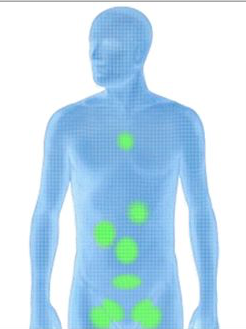
A Hernia most often appears within the abdominal wall but can also form in the upper thigh, groin or internally. Hernias are a weakness in the muscle or connective tissue that allows an organ or other tissue to push through the weak spot. This can result in a bulge that can be seen externally if on the abdominal wall or groin. Internal hernia or hiatal hernia can not be visualized externally.
Hernia Types:
Ventral
Ventral Hernia refers to defects or weaknesses of the abdominal wall. An Incisional Hernia involves a previous surgical incision. These hernias may present with any or all of the following findings; protrusions or bulging of the anterior abdominal wall tissue through the abdominal muscle cavity, abdominal pain, and nausea and/or vomiting.
Hiatal
Hiatal Hernias are located inside the abdominal cavity at the junction of the esophagus and the stomach at the level of the diaphragm. This condition is where the upper portion of the stomach this is usually located in the abdominal cavity has migrated through the esophageal hiatus into the chest cavity. These hernia’s usually present with reflux, episodes of nausea and are quite frequently seen in patients with experienced complications of the LAP-BAND.
Inguinal
Inguinal Hernias can form due to heavy lifting, coughing, obesity, genetics, etc. An inguinal hernia is a bulge of tissue through the inguinal canal in the lower abdomen in the groin area. Surgery is the primary treatment for inguinal hernias. It’s a very common operation and a highly successful laparoscopic procedure.
Internal
Internal hernias, if left undiagnosed and treated, can become dangerous. Internal hernias form within the abdominal cavity when internal organs or intestines protrude through a defect in the mesentery thereby possibly compromising essential blood flow.
Patients having weight loss surgery (WLS) either primary or revision are sometimes also diagnosed with having a hernia. Whether a hernia can be repaired concurrently with WLS or not, depends on the type of the hernia and also type of weight loss surgery. Further information regarding surgical treatment of hernias here.
